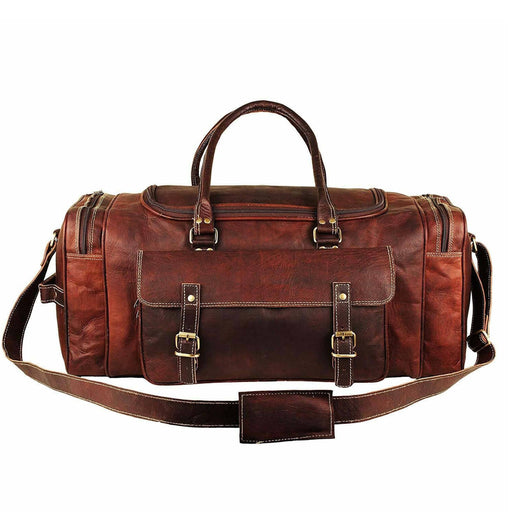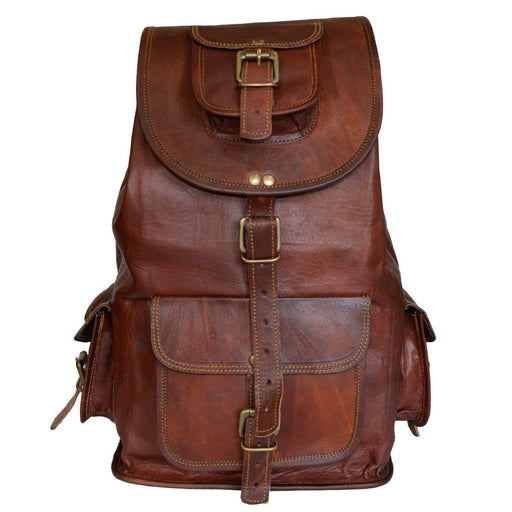
What is Goat Leather?
Know about goat leather, its place of production, how it looks and feels, its smell, its water resistance, its comparison with other materials such as buffalo leather and cow leather, and more. So stay tuned!
Goat leather is, as the name suggests, a material made up of goatskin. The same doesn't suggest its usability or effectiveness. There are different kinds of leather, such as cow leather, buffalo leather, and sheep leather, and different animal and lab-made leathers are also available. That is why knowing your leather is very important. Due to goat leather's strength, light weight, and softness, its use varies for making goat leather products such as:
- Apparel
- Shoes
- Bags
- Gloves
- Wallets
- Purses
- Rugs
- Accessories
Kidskin, a type of goat leather made from young goats, is used for making gloves, footwear, and clothing. Note that these are only a few goat leather products mentioned. Goat leather in India has a tremendous scope and gets used in multiple ways due to its quality.
Where is goat leather produced?
In ancient times, the finest goat leather came from Morocco, a North African country with European cultural influence. That leads to its other name, Morrocan leather, which isn't justified because many other countries produce and export goat leather products worldwide.
According to the data collected by the International Council of Tanners in 2015, China, Brazil, Russia, India, Italy, Korea, Argentina, the USA, Mexico, and Turkey are the top leather producers around the world. Goat leather: India has a stronghold in goatskins, and it supplies 18.68% of goat and kidskins in the world.
But from where do goat leather products come?
Farmers and herders keep large livestock consisting of different animals. Meatpackers take the leftovers from the food industry, process them, and send the goat hide to tanners for tanning. Here, goat hide becomes a global trade. Tanning will convert raw goat hides into finished goat leather. This processed goat hide goes through wholesale and retail channels.
The role of leather crafters starts here. According to type, texture, quality, etc., they buy leather and make goat leather products. Brands like MaheTri buy fine goat leather and employ their artisans to create curated goat leather products. To learn more about the process of making leather, read this blog.
How does goat leather look and feel?
Estimates suggest that 9% of total leather-based products are goat-leather products. But goatskin leather products are better than any other leather. It is known for its softness and lightweight features. Apart from this, it is also one of the most resilient leathers.
Goat leather products have lanolin, which makes them softer and more flexible. Goat leather products have a grainy, pebble-like texture with unique ridges. The material is thin, light, and strong. The soft feel and flexible material give it a vintage look and classy appearance.
Is goat leather waterproof?
Absolutely!
Goat leather is naturally water-resistant. Since goat leather products are water-resistant, they are easy to clean as well. A mild soap will work pretty well and keep your product fresh for ages. Vegetable tanning further increases its water resistance. This feature makes it more durable than cowhide.
Does goat leather smell?
Yes, it does!
This is the case with any leather product you buy. After all, it's an animal's skin. But perfectly tanned goat leather doesn't usually disappoint with a foul smell. One may encounter a bad smell from fresh goat leather products, but it is easy to get rid of that foulness. Sodium bicarbonate or baking soda are perfect neutralizers to remove it. With regular use and proper leather care, the goat leather product smell usually fades away.
Goat leather vs. cow leather—which one is the best?
There are many areas where goat leather is better than cow leather. Nowadays, many big brands are switching to goat leather for their products. Here are the reasons why, in the goat leather vs. cow leather battle, goat hide will win:
- Goat hide is suppler and softer than cowhide.
- Goat leather is more durable than cowhide because it is water-resistant.
- The thinner size of goat leather makes it lighter than cowhide.
- Bags and other goat leather products are not as stiff as cow leather products. Goat leather products are flexible.
Unless you want a rugged, insulated, and heavyweight leather product, goatskin will fall into the overall confusion of goat leather vs. cow leather.
Goat leather vs. buffalo leather
First, understand the difference between buffalo leather and cow leather.
Buffalo leather is an extreme version of cow leather. It is a lot stiffer than cow leather. The texture and pattern are more visible, such as in cuts and deeper groves. Buffalo leather is suited for making rugged items such as bags and shoes.
Now let's come to goat leather vs. buffalo leather.
Since goat leather is soft, flexible, and supple, it is best suited for making clothing items, book covers, gloves, etc. On the other hand, buffalo leather is rough and tough, so it is best suited for bags, shoes, and other such articles.
So, in the goat leather vs. buffalo leather debate, the winner depends upon the area of usage.
How much is goat leather priced in India?
Goat leather is one of the most economical leathers in India, and therefore, goat leather prices in India are affordable. Also, India is one of the biggest exporters of goatskin, so the goat tanning industry in India provides economical goat leather prices in India.
Multiple varieties of goat leather are available in India, so goat leather prices in India range from low to high depending on the quality requested. The price ranges from 50 to 500 per square foot.
Goat leather products prices in India vary depending on the quality. But the MaheTri brand is offering top-end goat leather products such as handbags, toiletry bags, DSLR/camera bags, duffle bags, office bags, living room chairs, and office chairs for as little as 1000 per piece.
Frequently Asked Questions
Let's answer all your questions about goat leather!
- Is goat leather a quality product?
Do you need leather that is strong, flexible, soft, and water-resistant? Then goat leather is a good option. So, it is a good product.
- How do I protect goat leather?
Keep goat hide products away from extreme humidity and wetness. It lasts longer and doesn't smell!
- What is goat suede?
The velvety texture made from rubbing the flesh side is goat suede. It is also soft, like velvet.
- How does one identify goat leather?
You will get pebble-like grainy structures on goat leather and goat leather products. The ridges are distinct in this kind of leather.
- Is goat leather suitable for bags?
Goat leather is naturally water-resistant due to vegetable tanning. Its smooth texture, fantastic durability, great flexibility, and lighter weight make it remarkably suitable for making bags.
- Are the goat leather products waterproof?
Goat leather is naturally water-resistant. But like every other leather, goat hide also goes through tanning with vegetable tannins. Hence, it further enhances its waterproof quality.
- My goat leather product smells; can I stop this smell?
Perfectly tanned leather won't smell bad. Therefore, you must ensure that you buy goat leather products from excellent brands like Mahetri. However, you may encounter a smell from an unused goat leather product. To remove that smell, apply baking soda to the bag and keep it in a plastic bag for two days. The smell will go away. But if you still can't get rid of it, don't worry! The smell will go away with repeated use in a few days.
- How do I identify goat leather?
Goat leather is soft, thin, and more flexible than cow leather because of the presence of lanolin. Goatskin isn't as rugged as buffalo leather. Goatskin has a pebble-like, grainy texture on its surface, giving it a distinct identity. Therefore, one can quickly identify goat leather products from the rest.
- How do I prevent goat leather from drying up?
After using your goat leather product, you will find that the surface is getting dry with time. Leather conditioning creams are available in leather care stores. Apply the cream, let it stay for a while, and then rub it with a clean, lint-free cloth.
Conclusion
Goat leather made with goat hide is one of the most affordable leathers. It is water-resistant, durable, and flexible. So, it offers a lot of scope for goat leather products. Goat leather in India has a lot of potential to grow with its premium-end products. Considering goat leather vs. cow leather, goat leather fairs better and offers a range of affordable products with premium texture.
Leather Bags for Men
Walker Leather Office Travel Bag
The super-stylish Walker leather unisex duffle bag is undoubtedly a trendsetter all year. This opulent, oblong weekender bag is made...
View full detailsTraveler Weekender Duffle Bag
This is the perfect solution for all your needs. This leather duffle bag has four big pockets on the exterior with two buckles. This...
View full detailsSpencer Hiking Backpack
The Spencer Leather Backpack is the perfect bag for all your adventures because it is designed to hold everything you need for a trip. Wit...
View full detailsWindsor Crossbody Bag
This unique brown leather crossbody bag for men and women will make every outfit of yours stand out effortlessly. This sling bag is handcrafted by ...
View full detailsCambridge Leather Satchel Bag
This handcrafted Cambridge Leather Satchel Bag is an exclusive product of MaheTri's Satchels collection for men and women. At MaheTri's leather ...
View full details




